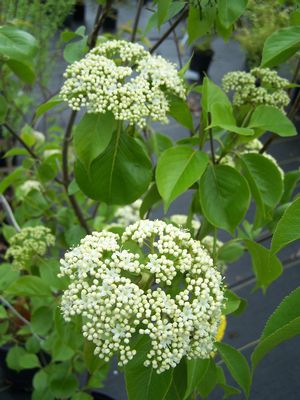Printed at http://www.quackingrassnursery.com/index.cfm/
Viburnum lentago
Nannyberry Viburnum
Plant Type:
DECIDUOUS SHRUBSViburnum lentago – The Nannyberry Viburnum has 2” to 4” elliptic leaves that remind me of apple foliage. Soft yellow emerging leaves from lead gray buds turn dark glossy green. Red-purple autumn color is likely, fairly consistent here at Quackin’ Grass, though not guaranteed. In early season attractive creamy yellow-white flowers open in early to mid-May in flattened circular cymes. Fruits with a glaucous bloom run through green, yellow and rose, sometimes all colors occurring at one time before aging to purple-black. All viburnums are good bird plants but this one especially so. Though not entirely clear to us we think that this may be an exception in that V. lentago may be self-fertile, not requiring another for cross-pollination and fruit production. Nannyberry Viburnum is a large tall grower and variable in width. We occasionally stumble upon one here and there in the woodlands surrounding Quackin' Grass; we always feel we've happened upon treasure.
Characteristics and Attributes for Viburnum lentago
Season of Interest (Flowering)
- Spring
Season of Interest (Foliage)
- Spring / Summer / Autumn
Autumn Interest
- Fruit / Berries / Seed Heads
- Autumn Leaf Color
Nature Attraction
- Songbirds
- Honey Bees & Native Bees
- Deer Resistant
Light
- Full Sun
- Mostly Sunny
Attributes
- Specimen
- Screen
- Shrub Border
- Wildlife Garden
- Hedge
- Hedgerow
Growth Rate in the Garden
- Moderately Fast
Soil
- Fertile
Origins
- Eastern North America
Propagated By
- Cutting Grown
Genus Overview: Viburnum
Common Name: Viburnum
Viburnum. This genus is full of fantastic, multi-season garden worthy shrubs. Garden heroes. Spring flowers, often large and showy, many with heady sweet fragrance are arranged in cymes. Some smell of musk (Viburnum dilatatum) while others produce no fragrance at all. Flowers are followed with berries. If late season and autumn berries are desired then planting two of a species will ensure fruit set; for instance, Viburnum dilatatum 'Erie' and V. dilatatum 'Michael Dodge' will pollinate each other and produce fruit. Viburnum cassinoides is closely allied with V. nudum; but if the flowering times do not overlap then there will be no fruit. However, if you plant V. nudum 'Winterthur' in proximity with V. nudum var. angustifolium, 'Longwood', 'Moonshine' or 'Pink Beauty' berries will abound. Another interesting example is V. lantana which crosses with V. burejaeticum and vice versa. Any V. plicatum f. tomentosum selection such as 'Shasta' or 'Shoshoni' will pollinate with all other V. plicatum f. tomentosum selections like 'Copper Ridges or 'Pink Beauty'. But if you were to plant two 'Shasta' side by side with no other V. plicatum f. tomentosum in near proximity then your effort will be fruitless. As with almost all in the universe of plants there are exceptions. There is one viburnum which appears to be self-fruitful, Viburnum setigerum the Tea Viburnum. Another interesting exception to the rule is Viburnum nudum 'Pink Beauty' which is also self-fruitful - a departure from its siblings. And on the other spectrum are two I can think of off-hand that are barren, Viburnum plicatum 'Roseum' and Viburnum plicatum 'Kern's Pink'. Oftentimes, the dwarf viburnums reamin in a juvenile state and do not produce fruit. All Viburnum of any size that do produce fruit are magnificent in the late season garden. And they feed all manner of birds. Larger, denser shrubs provide cover and nesting opportunities. Nearly all Viburnum have terrific autumn foliage colors, too. Viburnums are members of Caprifoliaceae. All prefer part to full sun and fertile soils. All are cutting grown. Many thanks to Gary Ladman of Classic Viburnums who generously set us straight regarding some of the details we had originally incorrectly lauded... ya can't know everything!



